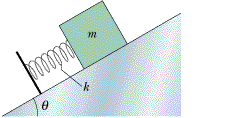
College Physics
11th Edition
ISBN: 9781305952300
Author: Raymond A. Serway, Chris Vuille
Publisher: Cengage Learning
expand_more
expand_more
format_list_bulleted
Concept explainers
Topic Video
Question
A block with mass m = 3.26 kg is placed against a spring on a frictionless incline with angle θ = 24.1° (see the figure). (The block is not attached to the spring.) The spring, with spring constant k = 10 N/cm, is compressed 14.9 cm and then released. (a) What is the elastic potential energy of the compressed spring? (b) What is the change in the gravitational potential energy of the block-Earth system as the block moves from the release point to its highest point on the incline? (c) How far along the incline is the highest point from the release point?

Expert Solution
This question has been solved!
Explore an expertly crafted, step-by-step solution for a thorough understanding of key concepts.
This is a popular solution
Trending nowThis is a popular solution!
Step by stepSolved in 2 steps with 2 images

Knowledge Booster
Learn more about
Need a deep-dive on the concept behind this application? Look no further. Learn more about this topic, physics and related others by exploring similar questions and additional content below.Similar questions
- A 12.0 kg box is given an initial push that starts it sliding across the floor. It eventually comes to a stop. If the box has an initial velocity of 3.5 m/s, how much work is done by friction to cause it to come to a stop? (Yes, you are correct, you do not know the coefficient of friction.)arrow_forwardA block with mass m = 2.20 kg is placed against a spring on a frictionless incline with angle e = 30.0°. (The block is not attached to the spring.) The spring, with spring constant k = 21.0 N/cm, is compressed 17.0 cm and then released. (a) What is the elastic potential energy of the compressed spring? (b) What is the change in the gravitational potential energy of the block-Earth system as the block moves from the release point to its highest point on the incline? (c) How far along the incline is the highest point from the release point?arrow_forwardmay someone please explainarrow_forward
- A pendulum consists of a 1.2 kg stone swinging on a 4.2 m string of negligible mass. The stone has a speed of 8.3 m/s when it passes its lowest point. (a) What is the speed when the string is at 56" to the vertical? (b) What is the greatest angle with the vertical that the string will reach during the stone's motion? (c) If the potential energy of the pendulum-Earth system is taken to be zero at the stone's lowest point, what is the total mechanical energy of the system? (a) Number i Unit (b) Number i Unit (c) Number i Unitarrow_forwardwhat is the unit of letter D?arrow_forwardA block of mass 500 g is attached to a spring of spring constant 80 N/m (see the following figure). The other end of the spring is attached to a support while the mass rests on a rough surface with a coefficient of friction of 0.20 that is inclined at angle of 30°. The block is pushed along the surface till the spring compresses by 10 cm and is then released from rest. (a) How much potential energy was stored in the block-spring-support system when the block was just released? (b) Determine the speed of the block when it crosses the point when the spring is neither compressed nor stretched. (c) Determine the position of the block where it just comes to rest on its way up the incline.arrow_forward
- Your answer is partially correct. The figure shows an 7.8 kg stone at rest on a spring. The spring is compressed 9.9 cm by the stone. (a) What is the spring constant? (b) The stone is pushed down an additional 26 cm and released.What is the elastic potential energy of the compressed spring just before that release? (c) What is the change in the gravitational potential energy of the stone-Earth system when the stone moves from the release point to its maximum height? (d) What is that maximum height, measured from the release point? (a) Number 172 Units N/m (b) Number 49.75 Units J (c) Number 79.75 Units (d) Number 64.7 Units cmarrow_forwardA mass of 10.0 kg is attached to a spring on a frictionless horizontal surface. The spring constant k = 504 Newtons / meters. The spring is stretched a distance of 0.500 meters. At that point, what is the Potential Energy (in Joules) stored in the spring?arrow_forward
arrow_back_ios
arrow_forward_ios
Recommended textbooks for you
 College PhysicsPhysicsISBN:9781305952300Author:Raymond A. Serway, Chris VuillePublisher:Cengage Learning
College PhysicsPhysicsISBN:9781305952300Author:Raymond A. Serway, Chris VuillePublisher:Cengage Learning University Physics (14th Edition)PhysicsISBN:9780133969290Author:Hugh D. Young, Roger A. FreedmanPublisher:PEARSON
University Physics (14th Edition)PhysicsISBN:9780133969290Author:Hugh D. Young, Roger A. FreedmanPublisher:PEARSON Introduction To Quantum MechanicsPhysicsISBN:9781107189638Author:Griffiths, David J., Schroeter, Darrell F.Publisher:Cambridge University Press
Introduction To Quantum MechanicsPhysicsISBN:9781107189638Author:Griffiths, David J., Schroeter, Darrell F.Publisher:Cambridge University Press Physics for Scientists and EngineersPhysicsISBN:9781337553278Author:Raymond A. Serway, John W. JewettPublisher:Cengage Learning
Physics for Scientists and EngineersPhysicsISBN:9781337553278Author:Raymond A. Serway, John W. JewettPublisher:Cengage Learning Lecture- Tutorials for Introductory AstronomyPhysicsISBN:9780321820464Author:Edward E. Prather, Tim P. Slater, Jeff P. Adams, Gina BrissendenPublisher:Addison-Wesley
Lecture- Tutorials for Introductory AstronomyPhysicsISBN:9780321820464Author:Edward E. Prather, Tim P. Slater, Jeff P. Adams, Gina BrissendenPublisher:Addison-Wesley College Physics: A Strategic Approach (4th Editio...PhysicsISBN:9780134609034Author:Randall D. Knight (Professor Emeritus), Brian Jones, Stuart FieldPublisher:PEARSON
College Physics: A Strategic Approach (4th Editio...PhysicsISBN:9780134609034Author:Randall D. Knight (Professor Emeritus), Brian Jones, Stuart FieldPublisher:PEARSON

College Physics
Physics
ISBN:9781305952300
Author:Raymond A. Serway, Chris Vuille
Publisher:Cengage Learning

University Physics (14th Edition)
Physics
ISBN:9780133969290
Author:Hugh D. Young, Roger A. Freedman
Publisher:PEARSON

Introduction To Quantum Mechanics
Physics
ISBN:9781107189638
Author:Griffiths, David J., Schroeter, Darrell F.
Publisher:Cambridge University Press

Physics for Scientists and Engineers
Physics
ISBN:9781337553278
Author:Raymond A. Serway, John W. Jewett
Publisher:Cengage Learning

Lecture- Tutorials for Introductory Astronomy
Physics
ISBN:9780321820464
Author:Edward E. Prather, Tim P. Slater, Jeff P. Adams, Gina Brissenden
Publisher:Addison-Wesley

College Physics: A Strategic Approach (4th Editio...
Physics
ISBN:9780134609034
Author:Randall D. Knight (Professor Emeritus), Brian Jones, Stuart Field
Publisher:PEARSON